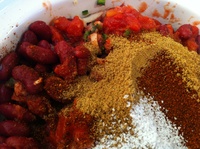It’s Memorial Day weekend; and in my mind the official start of the Summer.
I’ve been preparing steak for many years and this by far is one of my favorite flavor combinations. It’s simply rosemary, salt and pepper.
The best technique to a well cooked steak is to LEAVE IT ALONE. While there may be many a dissenter on that single point, I’m a firm believer in it. And it was one of the first lessons I learned about grilling in my early years working in restaurants.
The best tip is to always season your steak right before you cook it; particularly exceptional cuts like tenderloin. In this case I’m using flank which originally was lower on the beef food chain until fajitas became so popular. I really like it for this recipe. However, you can apply it to any cut you like.
I’ve also added a little roasted red pepper sauce. It is a great accompaniment with this steak; and, oh, so simple to make.
So, if you are looking for a simple, quick and delicious steak recipe for your Memorial Day - go no further than a stove top rosemary grilled flank steak. Enjoy!
For the steak
Ingredients
1/3 C fresh minced rosemary
1/4 C of kosher salt
1Tbls cracked black pepper
1 - 1 1/2lb size flank steak
Process
Mix first 3 ingredients in a bowl. Generously sprinkle then rub this mixture on all sides of the steak - right before you are going to cook it. For medium-rare: Place seasoned steak in the heated grill pan over high heat. After 3 minutes turn the heat down to medium. Cook for up to 2 more minutes. Turn steak over to the other side and repeat the process. (To check for doneness take one steak off grill slice down the center but not all the way through.) When the steak is done pull it from the grill pan, set it on a cutting board and let rest for up to 10 minutes. Slice thinly against the grain. Serve with Roasted Red Pepper sauce.
Yields 4 6oz servings.
This technique can be used for a charcoal or propane grill as well. If you use direct flame heat, a good addition to the process is adding some rosemary wood or stalks to add a little extra herbal smoke.
Roasted Pepper Sauce
Ingredients
4 red bell peppers, roasted & seeded
Salt & Pepper to taste
Process
Place peppers into a blender. Blend until ingredients are incorporated. When blended thoroughly, pour into a sieve and strain into a bowl. Place pureed pepper back into blender and add 1/8C of extra virgin olive oil. Blend to incorporate so that mixture is smooth. Add salt and pepper to taste. Serve with flank steak.
How to roast a pepper:
Over Flame:
Rub whole pepper with olive oil. Place over flame on stove eye. Turn with tongs as each side, top & bottom becomes charred.
In Oven:
Slice pepper in half. Rub outside with olive oil. Place on sheet pan cut sides down. Pop into oven under the broiler until skin is charred.
Once peppers are charred, remove from prospective heat and place in a bowl. Cover bowl with plastic wrap and let sit for up to 30 minutes. Remove plastic wrap, remove charred skin from peppers along with seeds and stem.








